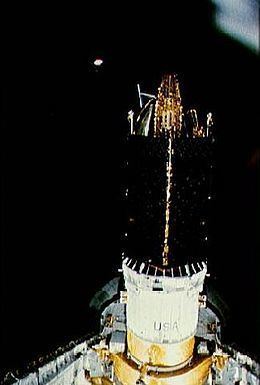SATCAT no. 13969 Launch date 4 April 1983 Mission type Communications satellite | COSPAR ID 1983-026B Launch site Kennedy LC-39A | |
 | ||
Deactivated June 27, 2010 (2010-06-28) Mission duration 7 years (planned); 27 years (achieved) Similar TDRS‑3, TDRS‑7, TDRS‑6, TDRS‑10, TDRS‑9 | ||
Tdrs 1 retirement
TDRS-1, known before launch as TDRS-A, was an American communications satellite which was operated by NASA as part of the Tracking and Data Relay Satellite System. It was constructed by TRW and launched by Space Shuttle Challenger on its maiden flight, STS-6.
Contents
History
While on the pad, problems were detected with Challenger's main engines and repairs were begun. During this time, a severe storm caused contamination of TDRS-1 while it was in the Payload Change-out Room on the Rotating Service Structure at the launch pad. Consequently, the satellite had to be taken back to its checkout facility, where it was cleaned and rechecked. Challenger finally lifted off from Launch Complex 39A of the Kennedy Space Center at 18:30:00 GMT on April 4, 1983.
Operations
Following deployment from Challenger, TDRS-1 was to be raised to its operational geosynchronous orbit by means of an Inertial Upper Stage, which consisted of two solid rocket motors, the first used to raise the orbit's apogee, the second its perigee. The first burn was successful, however the IUS went out of control during the second burn. TDRS-1 separated from the upper stage in a lower than planned orbit. It was eventually raised to geosynchronous orbit by means of its attitude control system. In order to achieve this, a team of engineers from the Goddard Space Flight Center in Greenbelt, Maryland worked for nearly three months using six one-pound thrusters on the errant satellite to push it 8,600 miles higher in space. The failure was later identified as a collapsed second-stage nozzle Techroll Seal, a flexible ring which allows the nozzle to move and provide directional control. The Goddard engineers' successful effort required 39 adjustment burns to correct the elliptical orbit to the 22,300 mi (35,900 km) high geosynchronous orbit desired for TDRS-1. In connection with this rescue, Goddard Space Center on November 26, 1984 honored a group of 34 individuals with the Robert H. Goddard Award of Merit, the highest level of recognition the Goddard Space Center can bestow on its employees.
Lifespan
TDRS-1 had a design life of seven years, however in April 2008, it was still operational on the twenty-fifth anniversary of its launch. Over the years, the orbit inclination has been allowed to increase so that, for portions of the day, it was able to be used for communications with the North and South poles. Along with Marisat F2, GOES 3 and LES-9, it was one of a number of satellites that were transferred to the US National Science Foundation for communications with the Amundsen-Scott South Pole Station. After Marisat was retired, TDRS-1 became the primary means of communication with the research station. The last functioning traveling-wave tube amplifier aboard TDRS-1 failed in October 2009, rendering the spacecraft unusable for communications purposes.
Decommissioned
The craft was moved into a decommissioning orbit beginning on or about October 21, 2009. Decommissioning was started on June 5, 2010 and passivation was completed on June 27, 2010. As of 2009, NASA had repositioned TDRS-3 to assume the duties of TDRS-1.
